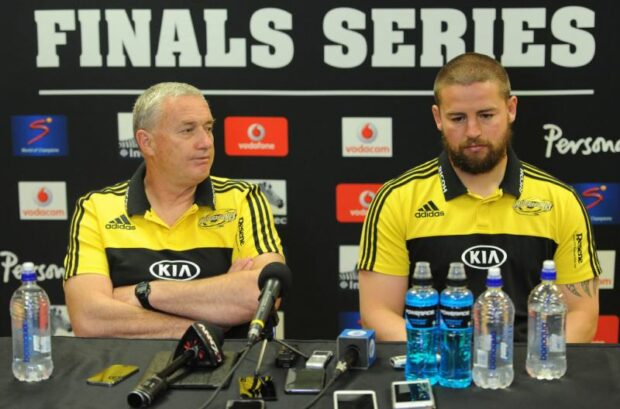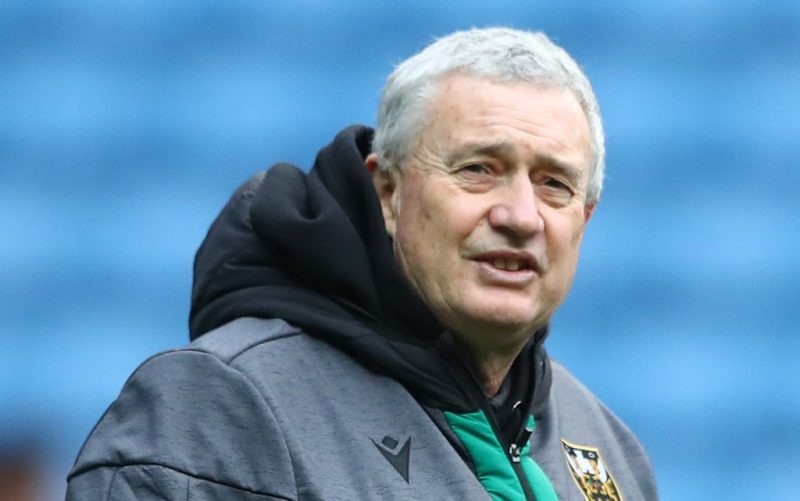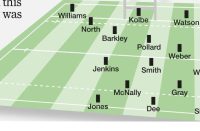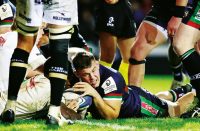CHRIS Boyd is not the most flamboyant Premiership coach on the roster, but there is no doubt that the straight-talking Kiwi with the deadpan delivery has transformed Northampton into a side who play with a flourish.
Boyd has turned the Saints from a weary, dispirited side during the last knockings of Jim Mallinder’s tenure into an outfit which has found its inner flair in double-quick time.
More significantly, rather than splashing out on overseas imports he has done it mainly by letting a posse of homegrown young guns off the leash, led by the likes of full-back George Furbank, flanker Lewis Ludlum and centre Rory Hutchinson.
In Boyd’s first season at Franklin’s Gardens after joining Saints from the Hurricanes, the New Zealander made an immediate impact by promoting the talent assembled largely by Dusty Hare, during the former England full-back’s seven year tenure as Northampton Academy manager before he retired just over two years ago.
Having given the sinuous Hutchinson a start at centre in a pre-season friendly against Glasgow, Boyd, right, pulled back the bolt on the Northampton Academy door – and out charged fly-half James Grayson, centre Fraser Dingwall, lock Alex Moon, tight-head prop Ehren Painter, hooker James Fish, and wingers Tom Collins and Ollie Sleightholme.
This new dynamic lifted the spirits of established Saints international stars like Courtney Lawes and Tom Wood, and envigorated new signings like Wales fly-half Dan Biggar and Springbok scrum-half Cobus Reinach.
It was a mix potent enough to see Northampton not only to a fourth-place finish in the Premiership table, but also to become the inaugural winners of the Premiership Cup, claiming their first silverware in five seasons after beating Saracens in the final.
It led to an England World Cup call-up for Ludlam alongside Lawes and Piers Francis, and a similar summons for Biggar and Reinach, while Hutchinson was pulled into Scotland‘s pre-World Cup camp.

However, Boyd had sown the seeds of a revival strong enough to withstand their absence, and when the Saints international cohort returned from Japan in November they found their club competing for the top of the table slot with Bristol.
Going into the first Premiership round of the New Year against Wasps at the Ricoh today the pecking order has changed slightly, but only because Northampton are now chasing Exeter for top slot, with only one league point in it.
Ask Boyd what goals he set when he first arrived, and what his targets are this season, and you get an immediate sense of a coach who has worked out his own template – and is a very clear communicator.
“I don’t set goals and never have. If you play well you go up the ladder. You can control how you play, and that’s all. If you play well consistently you will be in the chase for silverware. So, performance is critical, and the guys enjoying the game. But there is no aim to be top two, or top four.”
Although signing a New Zealand coach is no automatic guarantee of success for a Premiership club – in the same way that signing a former All Black can sometimes backfire – Boyd’s credentials stack up.
He was an assistant coach with Wellington, the Natal Sharks, and Tonga – notably when they beat France at the 2011 World Cup – before coaching the New Zealand U20 side.
Boyd then became the most successful coach the Hurricanes have had by guiding the Wellington-based franchise to two successive Super Rugby finals, losing the first narrowly before beating the Johannesburg-based Lions 20-3 to win the title in 2016. The following season his Hurricanes side secured a thrilling 31-31 midweek draw with the 2017 British & Irish Lions.
Boyd explains that making the transition from Super Rugby to the Premiership involves important adjustments.
“There are some obvious differences, such as we play during the day here, rather than at night. In Super Rugby there is a shedload of travel, whereas here we usually go by bus on the day, or the night before.
“Organisationally that makes it different. The fact that you are in Sydney one week and Jo’burg the next in Super Rugby might be an attraction to young guys, but, overall, the boys seem happier here that they can get home the same evening after playing, so generally it’s more positive.”
His embracing of the cause of players, and fans who attend matches come rain or shine, ends with this important observation: “Of course, I understand broadcasters have a big influence, but players enjoy playing at 3pm more than 7pm.”

When it comes to coaching in a new environment Boyd is pragmatic.
“It’s the same game, but the biggest differences are in terms of fine-tuning. The game here is based more on contact, whereas Super Rugby is more about finding space. It’s also refereed differently, and for me that took a bit of sorting out. For instance, in Super Rugby very few teams scrum for penalties – they just want to get the ball out – whereas here they do.”
Boyd has a reputation for encouraging an attacking style, earned especially during his successful tenure at the Hurricanes where he charted the course for All Black stars Beauden and Jordie Barrett.
So, how has he gone about setting out his stall at Northampton?
Boyd responds: “It’s about your personal philosophy, and that of the team. It also depends on the skill-set of the team you’ve got, because really you have to adapt your game to your cattle – and I was happy to find here a lot of players with good skill sets.
“We are not always the most accurate in the way we play, or the most brutal, but you find that if you all pulling the same direction, and all buy into it, then you pull through together.”
Boyd then reveals the core elements in a coaching mindset that has given the Saints wings to fly this season.
“We haven’t got a rigid structure – and I don’t want it to be so rigid that we cannot adapt on the hoof to what is in front of us. Teams with a high degree of rigidity are successful up to a point, but then you find that they cannot adapt when it does not work. Here we have plans A, B, C and D.
He says the ability to adapt is there because the raw material at Northampton compares with that at the Hurricanes.
“My immediate impression was not so much of a difference in the raw material in terms of ability and skill, but more of a reluctance to show it. Players up here are potentially as skilful, but there is such a high emphasis on accuracy, and not making mistakes, that players are less likely to try things.”
Boyd adds that the key to progress is how you practice: “It’s why I encourage players to practice their skills under extreme pressure in terms of lack of time and space. So, when we encourage individuals to push their skills, some thrive and can keep pushing on, whereas with others you might realise they have reached their limit, and then ratchet it back until they come to their sweet spot.”
The enthusiasm Boyd has for his new mission at Northampton is evident when he talks about the welcome he has had in the East Midlands, and the quality of the infrastructure.
“One of the things in Super Rugby is that you play every week in international stadiums, but they are usually less than full, whereas Franklin’s Gardens is what I call a boutique environment. We get fantastic support in a great little rectangular stadium, which is almost always full, and we play on an excellent pitch.
“It’s a great place to play footy and is very well organised. I had visited Northampton when Wayne Smith was the coach, and was watching once when they played Leicester, so I knew something about the environment before I came.”
Boyd continues: “The coaching group we have assembled works well together, and I’m really happy we’ve retained Phil Dowson (forwards) and brought in Sam Vesty (attack) and Matt Ferguson (scrum).”
He says that there are also encouraging signs that Saints are starting to assemble a squad with the depth to challenge for silverware both domestically, and in Europe.

Boyd says that the arrival this season of two of his fellow-countrymen, centurion All Black tight-head Owen Franks, who is expected to return later this month after a thumb injury and former Hurricanes centre Matt Proctor, is a significant bonus.
“Owen has been a world-class player – and he’s very determined to ply his trade successfully up here. He’s only 30, and I know he has hopes of playing for another three or four years. Proctor is understated, but he was very good for the Hurricanes, and was rewarded with one Test (for the All Blacks). He is a quality footballer.”
Boyd says how Premiership clubs cope with Six Nations calls is crucial: “The interesting thing will be how rosters cope when it is on. Some clubs lose nobody, whereas others lose five or six players. What having a good (Premiership) start does is take a bit of pressure off that Six Nations block.”
Boyd believes also that a European Cup quarter-final is still achievable, despite the requirement of two wins from their remaining games, one of which is away to Top 14 leaders Lyon.
“We will put our best side out against Benetton, and go from there. Lyon are very difficult to beat at home, and are still near the top of the table in France – but, yes, we will be pursuing a quarter-final opportunity,” he said.
This positive outlook is reflected in Boyd’s response when asked to quantify how much better this Northampton side can get.
“There is still plenty of growth in it; Painter is 21, Fish 22, and Moon, Ludlam, Alex Mitchell, Grayson, Dingwall and Furbank – who did an exceptional job moving from 15 to 10 when Dan Biggar was injured last weekend – are all youngsters.”
He adds: “Harry Mallinder is coming back from injury, but he’s capable of playing every position in the backline from 10 to 15. Lots of things happen around him when he plays – and if they are more comfortable in space, as he is, then they are probably more a 15 than a 10.”
Boyd’s appraisal of the hand he was dealt when he arrived at Northampton reflects a collaborative approach in which he refuses to hog the limelight.
He says: “Credit to who brought that crop of youngsters in. All you can do as coaches is turn that potential into performance. Those we’ve given those opportunities to have returned that faith, and our aim is to bring young high potential English players through.”
Chris Boyd is as down-to-earth as they come, but his ambition is for Northampton to soar.























